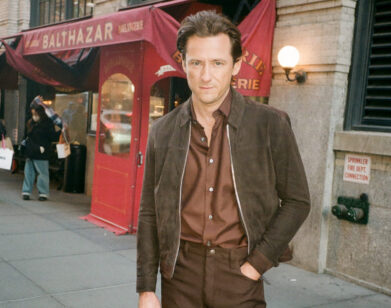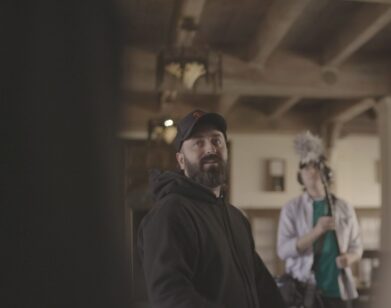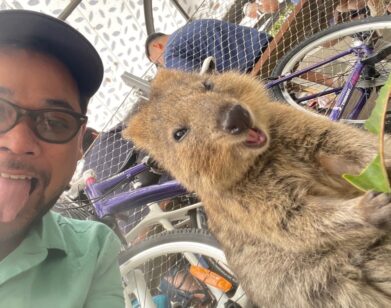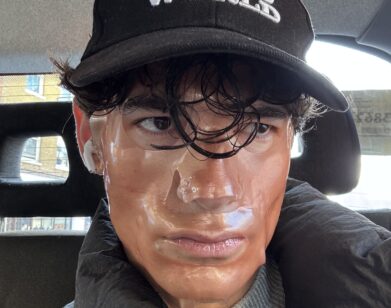Hidden History
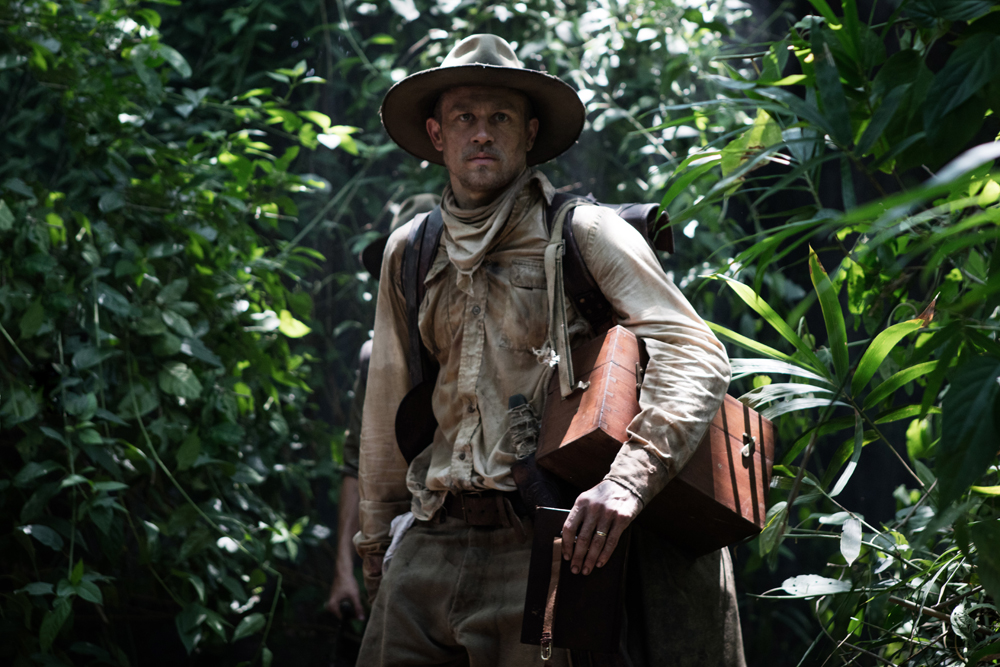
CHARLIE HUNNAM IN THE LOST CITY OF Z, AN AMAZON STUDIOS AND BLEECKER STREET RELEASE. PHOTO: AIDAN MONAGHAN. COURTESY OF AMAZON STUDIOS & BLEECKER STREET.
David Grann may be every reporter’s favorite reporter. But if his name is not widely known among civilians, it may be because even when he appears in his stories—as he does, muddied and afflicted by every imaginable pest during his search for an ancient Amazonian civilization in his great The Lost City of Z, which James Gray has adapted for a film starring Charlie Hunnam, Robert Pattinson, and Sienna Miller, out this week—he is never a distraction from the story. And, my, what stories. Grann’s newest, Killers of the Flower Moon: The Osage Murders and the Birth of the FBI (Doubleday), about the mass murder of members of the oil-rich Osage tribe of Oklahoma, is part police procedural, part The Untouchables, and an altogether horrifying chapter from America’s past, brilliantly told.
CHRIS WALLACE: Is this your first story that didn’t begin as a magazine piece, but went straight to book?
GRANN: Yes. It’s interesting, so The Lost City of Z began as a magazine piece and it was the first piece I’d done for The New Yorker where I finished and I said, one, I’m not sick of it, and, two, there are so many more places to go. There were still doors to open. The magazine piece focused very much on my trip and there was so much historical research to be done about [Colonel Percy Fawcett, who disappeared in the Amazon in search of “Z”] and who he was. This one could really only be a book, in its breadth and structure. The way I needed to tell it—with three largely different points of view—it was much less containable.
WALLACE: The last point of view, after you’ve solved the murders and sort of wrapped up the case, is your own. What do you see as your role in the telling of these stories?
GRANN: That’s something I think a lot about, and it’s kind of evolved over time. Early in my career I was much more confident in the almost omniscient powers of a reporter, because you could find anything out and then write the definitive piece about it. And as I got older, I got much more humble about trying to learn everything, with what eludes you, especially with history. Pieces of it are always washed away. This story in itself has been largely washed away and lost to history. And I wanted the structure to reflect that. In the first section, Mollie Burkhart Osage can only see part of the story as history is unfolding and she is trying to make sense of who’s murdering her family. Then Tom White, the FBI agent who then comes in the second chronicle, was able to resolve the central conspiracy and bring some great element of justice to the case. In the third chronicle, which is my own as a reporter, I’m trying to show what was missed and what was lost, trying to make sense of the pieces of evidence that exist. I mean, I think I did a pretty good job digging up new cases and identifying a new killer who had never been mentioned. But it was in service of the larger meaning of the narrative, which is, how do we make sense of the life and the world we live in? How do we make sense of history as it’s unfolding? What can we recapture? And why it’s so important, so that there can be some piece of justice to so many of these people who for a hundred years have been haunted by unresolved murders in their family. You know, I write stories about hunts for the giant squid and things—they’re not so disconcerting. But when you go there and you meet with so many of the Osage and they start to say, “Can you look into this? Here are some documents. Can you do this?” It’s heart-wrenching and I want to do everything that I can. And I tried my best, but at some ultimate level, I don’t think part of this will ever be fully recovered and I wanted to show that. I wanted to show that and hopefully have an intimacy of human beings, so, by telling it from these individuals’ perspectives, I felt like it wouldn’t just be a cataloging of dust. They are real victims. There are real murderers. Getting at the truth, though, can be elusive.
WALLACE: The primary villain in the story is horrifying. But in some sense, the antagonist here, in negative, is the erasure of history, the wiping out of a story. I’d never heard of the Osage murders before.
GRANN: It’s like grasping a wisp of evidence, trying to catch the ether. There’s a lot of people left on the margins of life. I’d never heard of it before I started looking it up. Let’s be honest, at the time this was happening, most people didn’t give a shit. I mean that’s the true tragedy, the true horror.
WALLACE: The parallels to today are staggering.
GRANN: Staggering. I write a lot of crime stories, but you can’t help but be like, “Are you kidding me?” The prejudices from the government level to the politicians, the way they even spoke about the Osage, the indifference, the callousness, that these people could be treated this way. Everyone turned a blind eye. This was basically a culture of complicity—and I think that’s a really important point. There is an extraordinary villain in this book, it’s like something out of a Cormac McCarthy [novel]—biblically evil, it’s just beyond fathom—but there was a deep culture complicity. These crimes did not happen if other people didn’t actively conspire or quietly conspire, by covering up autopsies… We’re in the 1920s, we’re dealing with telegraphs, mass communication, cars, railroads going across the country, and a genocidal crime is taking place in the heart of our country. Long after the American Indian Wars, it’s still happening. You’re always trying to figure out what stories are about at some deeper level—when you start them, you don’t know—and I think part of it is what we’ve talked about thematically about history. But I would say it’s about this original sin at the heart of our historical narrative that we have never fully reckoned with. And this story is a microcosm of that.
WALLACE: And here we have the already iconic image of this week, of the last of the protest camps burning in North Dakota.
GRANN: I spent a long period of time interviewing a young Osage war veteran who fought in Afghanistan, won a purple heart. He basically walked across the country from Oklahoma to North Dakota to be with the Sioux. And here are these events separated by nearly a century. The Osage were incredibly wealthy and were actually exploiting fossil fuel for their wealth. And the Sioux are obviously not getting money from the oil and are trying to protect their natural environment, but I was struck in speaking to the Osage, I spoke to a former chief, in that there is this overlapping theme that connects these events.
WALLACE: It’s sovereignty.
GRANN: That’s exactly what it’s about. And, frankly, I was struck by how many Osage had been galvanized by Standing Rock and how many draw from their own history when they go there.
WALLACE: You mentioned the way that you’ve changed as a storyteller and I wonder if that’s format, if it’s these massive scale things. Your success rate, if we can call it that, on landing these big fish—the payoff of Z, fingering another killer here—is pretty great. Is there a great peril in telling these stories this big? How did you come to this sort of format?
GRANN: I’m sure every author has their own process. You hear something that is intriguing, but can you tell it? I spent a year basically FOIA-ing every institution I could find, writing to every courthouse, every sheriff’s office, every penitentiary, to see what records they had. And, for that year, boxes and envelopes would arrive periodically. I would put them in the corner, wouldn’t look at them. After a year I said, “Okay, now let’s see what we’ve got.” I began to look at the material and I said, “There may be enough here. I might be able to do this.” But there is always an element of rolling the dice. You don’t know what you’re going to find and you’re nervous because you still know there are gaps in what you’re going to find. I think you get into trouble as an author and a journalist when rather than owning the gaps, you try to elide them. One of the keys for me is actually making those gaps central to the story. So part of it is chasing ghosts, rather than being like, “Oh, it’s all tidy and neat.” No, no, no. Show that, like, “I got you this far, but I can only get you so far.”
WALLACE: This is Sherlock Holmes’s thing—and Conan Doyle is all throughout your work—of making sure one never looks for evidence to fit a hypothesis, rather than the opposite.
GRANN: That’s the moment of truth, where you have to say, “Okay, the narrative I’m writing in my head does not form to the narrative I am encountering. How do I reconcile this and deal with it head on?” That’s a pivot moment. At first you’re in a moment of shear anxiety and peril—”Oh, God, this isn’t working out”—and then eventually you realize the interesting elements of the world often give you what you need if you are willing to see them.
WALLACE: Was there a first story that led you to this sort of big-game story hunting?
GRANN: Like many people, I kicked around, struggled to become a writer, finally got my first full-time job around 27, 28, at The Hill newspaper. They hired me as a copy editor, which was kind of funny because I’m semi-blind because I have an eye disorder. I was the worst fucking copy editor ever, which helped me out of the job quickly. I ended up covering politics, mostly by necessity, and then I went to The New Republic. I was not very good at newspaper reporting. I’m just not quick enough, and I always tend to tell things as stories. So I would always write my newspaper stories, and people would look at it and be like, “Let’s just move your last paragraph and make it your second paragraph.” I never studied reporting, so, silly me, I had never read a lot of narrative nonfiction or the kind of icons that most people read when they’re young. I guess I read Joan Didion when I was young, but that felt slightly more memoir-ish. And then I did a story about a Traficant [a former House representative from Ohio], who in many ways is a predecessor to Trump in terms of his politics, his nationalism. When I did that story, he had some alleged ties to the Mob, and I went back to Ohio and discovered this wiretap that he had been caught on with these mobsters named, like, Lenny the Crab, and the language was so real and so different than everything that I had been hearing from Washington. In Washington, he was the honorable gentlemen from Ohio, but suddenly I’m listening to this wiretap, and he’s cursing every other word. I thought, “That’s what I want to write. That’s how I want to tell stories. I want to get to the authentic voice of people.”
WALLACE: Again, I’m staggered by your success rate.
GRANN: Well, what’s the success rate in baseball? Thirty percent and you’re doing it right. I would say with this, you’re successful if it’s like one out of one hundred that you get the fruit of something. So, a low batting average. [laughs]
KILLERS OF THE FLOWER MOON COMES OUT NEXT TUESDAY, APRIL 18, 2017. THE LOST CITY OF Z COMES OUT ON FRIDAY, APRIL 14.

